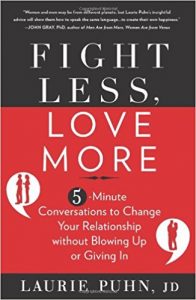Our mouths were filled with laughter; our tongues sang for joy. Then it was said among the nations, “The LORD has done great things for them.” (Psalm 126:2)
“We realize that we enjoy working together so much that it feels like play. We’ve taken to calling it Plurk.” (Harville Hendrix and Helen LaKelly Hunt)
There is the story about the man who goes to see his doctor for an exam. After getting a thorough checkup, the doctor calls the man’s wife into his office without the husband and says that her husband is a very ill. He has a life-threatening condition and things do not look very good.
However, if she is willing to be at the husband’s beck and call 24 hours a day, seven days a week, and is willing to cater to his every want and desire, making him special breakfasts in the morning, giving him wonderful meals in the evening, sending him off to work with wonderfully prepared lunches, making love to him whenever he’s desirous of her, and generally doing everything to make him completely happy, for the next several months, there is an excellent likelihood her husband will pull through it and be okay.
As they are driving home the husband turns to his wife and asks, “So what did the doctor tell you?”
To which his wife replies, “He told me you’re going to die.”
Humor serves a couple by providing the space to lighten up the relationship so that neither takes what the other said or did, or the current situation, so personally. The man in the story seemingly needs compassion and sympathy, but what his wife gives instead helps her manage her own anxiety, thus allowing for an important challenge to her husband. Her playfulness makes it possible for him to take charge of his own life – both metaphorically and literally.
Love and good will are essential components of marriage, yet even with love we still become anxious. An anxious response can get confused as a loving and caring one. When we’re anxious we often end up doing what is good for us since it relieves our anxiety, but it’s not necessarily good for the one we supposedly took the action for.
Lighten up
Rather than work on the relationship, each spouse can focus on their own issues in order to become a mature, capable and responsible adult, and do so out of a sense of joy and delight. Work implies a seriousness, which is problematic and points to a lack of self-differentiation. When overly serious we operate from a highly anxious state that cuts us off from our higher levels of functioning – our capacity to reason and problem-solve. Seriousness keeps us operating out a reflex mode. We react rather than respond. There is a Mary Engelbreit poster that says: “Life is mysterious, don’t take it so serious.” Humor helps move us outside a seemingly hopeless situation and to see with new eyes.
Learn to go in the other direction
Akin to humor is the paradoxical intervention when we go along with, or exaggerate, the situation. “It’s the worst thing that could have happened. I think I’ll stay in bed!” Or, “My car broke down; life is terrible.” We sometimes play a game of “Pet Peeves.” Each person must state a complaint and exaggerate it while everyone else exhorts, “That’s terrible!” or “I hate when that happens!” One can’t help have a hilarious time.
George complained that his wife, Sue, makes annoying facial grimaces whenever she thinks he’s worried, causing George to be angry. I suggest he learn to misread her and imagine her facial expression as her “sexy” look. I say this not because it’s right or wrong, but because it frees him to see her less intensely and provide a new way to respond. I chide that he may not know what “that face of hers” really means. Such playfulness slows us down and lowers our reactivity.
Make play central to the relationship
Couples can cultivate play, as well as joy and delight. Playfulness gives the space needed for intimacy as surely as repeating someone’s question gives time for an answer.
When couples first date they tell how they love having fun and even being silly. They do interesting things; they play. Once they start to court each other and move toward marriage they’ll say, “Now we’re in a serious relationship.” Somehow we link commitment to seriousness. The antidote to too much seriousness is play.
Children know how to play and sometimes have such a good time that other kids begin to watch and even take part in their play. Play is attractive and magnetic. We knew something then that is still extremely useful today. Individuals who know how to play make great partners. Playful couples are magical to observe. They have a twinkle in their eyes, a lightness without being flippant. Each partner is loose while remaining solid and grounded. They are grace in action. In short, they remind us that play is a virtue we need to take seriously.


 Do you and your mate get into the same arguments, time and gain? Do you encounter family members who have the uncanny ability to push your buttons and get in your face, even though you set out to steer clear of strife? As a lawyer and couples mediator I have observed the same dumb arguments ruining relationships. In my book
Do you and your mate get into the same arguments, time and gain? Do you encounter family members who have the uncanny ability to push your buttons and get in your face, even though you set out to steer clear of strife? As a lawyer and couples mediator I have observed the same dumb arguments ruining relationships. In my book 



